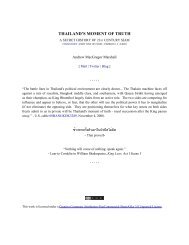THAILAND'S MOMENT OF TRUTH - ZENJOURNALIST
THAILAND'S MOMENT OF TRUTH - ZENJOURNALIST
THAILAND'S MOMENT OF TRUTH - ZENJOURNALIST
You also want an ePaper? Increase the reach of your titles
YUMPU automatically turns print PDFs into web optimized ePapers that Google loves.
of the gate over there: if any commoner in the land has a grievance which sickens his belly and<br />
gripes his heart, and which he wants to make known to his ruler and lord, it is easy: he goes and<br />
strikes the bell which the King has hung there; King Ram Khamhang, the ruler of the kingdom,<br />
hears the call; he goes and questions the man, examines the case, and decides it justly for him. So<br />
the people of … Sukhothai praise him...<br />
The authenticity of the inscription is the subject of considerable debate: it is, almost certainly, fake. But<br />
the paradigm of monarchy it depicts became central to the modern Thai reinvention of kingship. As<br />
Prince Dhani said in his 1946 lecture:.<br />
The old Thai had their own traditions of kingship. The monarch was of course the people's leader<br />
in battle; but he was also in peace-time their father whose advice was sought and expected in all<br />
matters and whose judgment was accepted by all. He was moreover accessible to his people, for<br />
we are told by an old inscription that in front of the royal palace of Sukhothai there used to be a<br />
gong hung up for people to go and beat upon whenever they wanted personal help and redress...<br />
The ideal monarch abides steadfast in the ten kingly virtues, constantly upholding the five<br />
common precepts and on holy days the set of eight precepts, living in kindness and goodwill to all<br />
beings. He takes pains to study the Thammasat and to keep the four principles of justice, namely:<br />
to assess the right or wrong of all service or disservice rendered to him, to uphold the righteous<br />
and truthful, to acquire riches through none but just means and to maintain the prosperity of his<br />
state through none but just means...<br />
The ten kingly virtues above cited are often quoted in Siamese literature... They are: almsgiving,<br />
morality, liberality, rectitude, gentleness, self-restriction, non-anger, non- violence, forbearance<br />
and non-obstruction.<br />
Bhumibol’s role as father of his people was emphasized through the royal development projects<br />
sponsored by the palace and his travels around the country to inspect the work being done for the benefit<br />
of the poor:<br />
The monarch has been highly praised for his dedication to royal development projects that aim at<br />
helping the poor, particularly the rural and highland people. Beginning in the 1950s, the breadth<br />
and scope of the royal projects expanded enormously especially during the Cold War and after<br />
1973... Several of them began as non-governmental but eventually most of them were integrated<br />
into government bureaucracies and budgets. The truth about these projects, and their successes<br />
and failures, will probably remain unknown for years to come, given that public accountability<br />
and transparency for royal activities is unthinkable. Suffice it to say that the endlessly repeated<br />
images of the monarch travelling through remote areas, walking tirelessly along dirt roads,<br />
muddy paths and puddles, with maps, pens and a notebook in hand, a camera and sometimes<br />
a pair of binoculars around his neck, are common in the media, in public buildings and private<br />
homes. These images have captured the popular imagination during the past several decades.<br />
Bhumibol is portrayed as a popular king, a down-to-earth monarch who works tirelessly for his<br />
people and, we may say, has been in touch with his constituents for decades long before any




